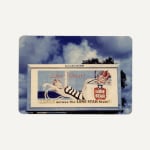[American Billboards]
Lone Star Beer, Houston, c. 1957
Vintage Ansco "Printon" from Kodachrome positive
2 1/4 inches x 3 1/4 inches
Sold with custom acrylic wall mount.
$400.00
Sold with custom acrylic wall mount.
$400.00
Drawn from an extensive collection of images created for marketing research during the golden age of advertising, these early color photographs were shot in situ across the highways, cityscapes, and...
Drawn from an extensive collection of images created for marketing research during the golden age of advertising, these early color photographs were shot in situ across the highways, cityscapes, and backroads of a changing Postwar landscape.
The billboards in the photos offer, to the passing consumer, a chance at happiness as realized by the purchase of a new car, a cold beer, sliced bread, skimmed milk, honest-tasting cigarettes, a gift for the Mrs., a pop gun for junior, dog food for the dog, Saltine crackers crisp as a new dollar bill, and countless other staples of middle-class living.
The documentary nature of these images, with their innumerable inherent ironies, speaks to the work of Evans and his contemporaries. While both the form and subject matter recall Eggleston, Shore, and others New Color photographers who utilized straightforward aesthetics and kodachrome-soaked hues to capture the malaise and sublimity of the suburban experience.
The photographs were created using the Ansco Color Printon Process, which was patented in 1943 and allowed photos to be made directly from color transparencies without the use of an internegative.
The billboards in the photos offer, to the passing consumer, a chance at happiness as realized by the purchase of a new car, a cold beer, sliced bread, skimmed milk, honest-tasting cigarettes, a gift for the Mrs., a pop gun for junior, dog food for the dog, Saltine crackers crisp as a new dollar bill, and countless other staples of middle-class living.
The documentary nature of these images, with their innumerable inherent ironies, speaks to the work of Evans and his contemporaries. While both the form and subject matter recall Eggleston, Shore, and others New Color photographers who utilized straightforward aesthetics and kodachrome-soaked hues to capture the malaise and sublimity of the suburban experience.
The photographs were created using the Ansco Color Printon Process, which was patented in 1943 and allowed photos to be made directly from color transparencies without the use of an internegative.
![[American Billboards], Lone Star Beer, Houston, c. 1957](https://artlogic-res.cloudinary.com/w_1600,h_1600,c_limit,f_auto,fl_lossy,q_auto/artlogicstorage/dollc/images/view/ebc50d4300a4ede6eb38ad9451169ea1/daniel-oliver-american-billboards-lone-star-beer-houston-c.-1957.jpg)
![[American Billboards], Lone Star Beer, Houston, c. 1957](https://artlogic-res.cloudinary.com/w_1600,h_1600,c_limit,f_auto,fl_lossy,q_auto/artlogicstorage/dollc/images/view/c26c0d5caf9147cbac9ef030e44b899fj/daniel-oliver-american-billboards-lone-star-beer-houston-c.-1957.jpg)

